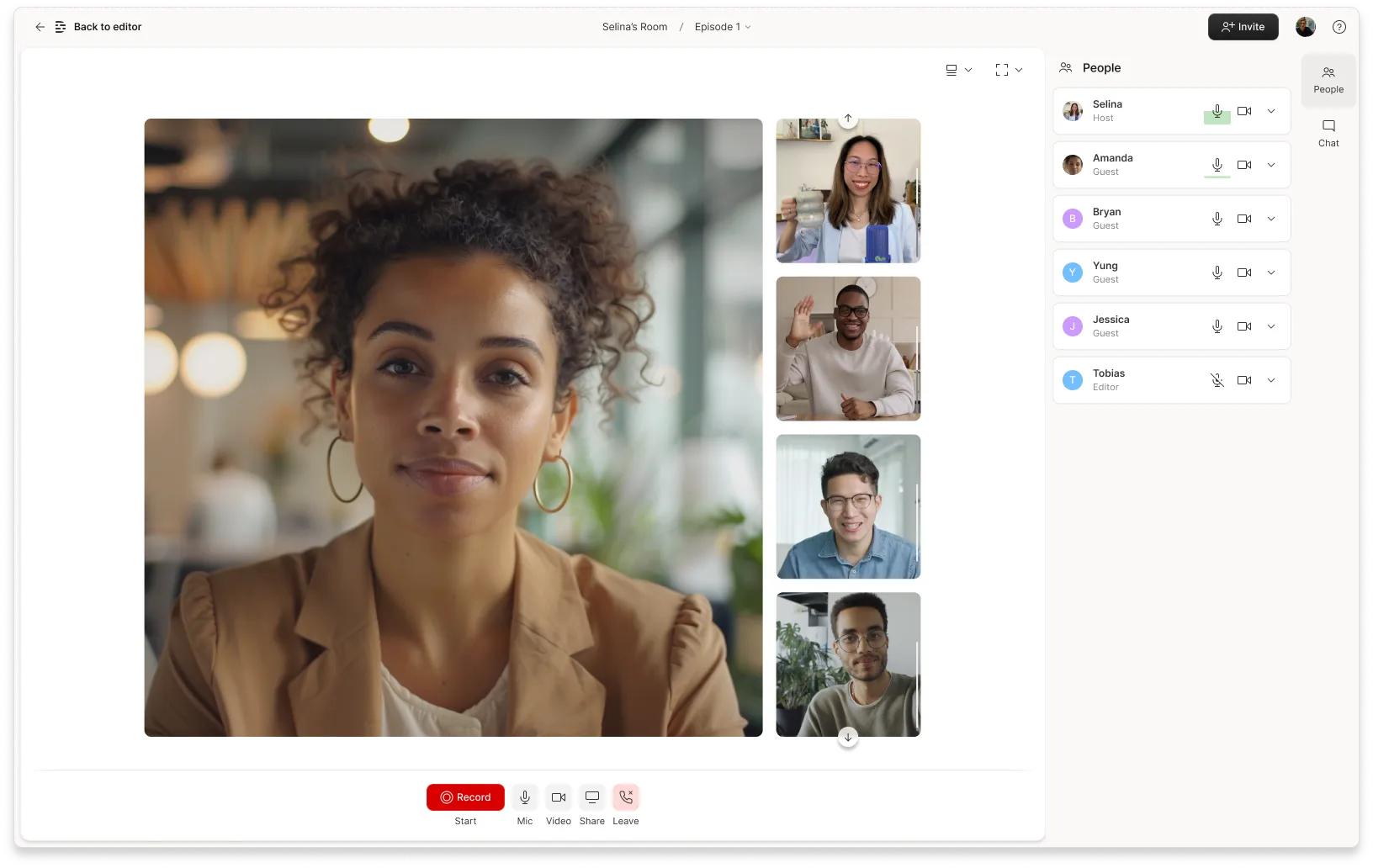You hear them constantly but rarely think about them—voiceovers are the invisible backbone of media. That iconic movie trailer voice, the narrator guiding you through documentaries, the characters in your favorite animations, and even the helpful instructions in YouTube tutorials—they're all part of the vast world of voiceover work.
However, that's not to say the art of voice acting is easy—it's a specialized skill requiring technical precision, emotional range, and versatility. There's a reason professionals can command premium rates for their vocal talents.
The voiceover landscape is transforming rapidly with AI entering the scene—creating both exciting possibilities and legitimate challenges. This guide cuts through the hype to deliver practical insights on crafting high-quality voiceovers, whether you're using traditional methods, AI tools, or finding your own hybrid approach.
What is voiceover? Definition and meaning
Voiceover, or VO, is when an off-camera voice narrates a scene or adds context. Voiceover has been around for ages—TV, radio, film, and theater have all used narration, commentary, or dialogue in some form to move a story forward. In 2025, voiceover remains essential across traditional media while also expanding into new digital formats like podcasts, AI-generated content, and interactive experiences.
During the early days of radio, voiceovers were essential for setting scenes, describing events, and providing context because they didn't have many visual tools.
As TV shows and filmmaking developed, voiceovers found a place in narrating stories, providing backstories, and expressing a character's inner thoughts. Voiceovers have improved in quality and versatility thanks to tech advances: things like clearer sound, better editing capabilities, and even AI voice technology that can edit and alter voices with unprecedented realism.
AI-driven voiceover trends
The rise of AI-driven voiceovers is changing how content creators produce spoken narratives. Digital voice replicas can be created with near-human precision, letting advertisers automate campaigns quickly. Under new agreements like the partnership between SAG-AFTRA and Narrativ, talent can maintain control over how their voices are licensed and specify when and where they’re used. This ensures that brand integrity is preserved, and performers retain rights over their digital likeness. Legislation is also evolving, with proposed bills such as New York’s digital replica licensing bill aiming to safeguard performer consent for AI-based usage.
Voiceover vs. voice acting: Key differences
It's common for people to mix up "voiceover" (sometimes written as "voice over" or "voice-over") with "voice acting." At a glance, they might seem like two sides of the same coin, but there are subtle differences between them. It's true that they both use the voice as a tool, but their purpose and techniques are different.

What defines voiceover work
The main purpose of voiceover is narration. It's the voice you hear in the background of a documentary that guides you through the story, or the sports commentator you don't see.
Here are a few key differences to keep in mind:
- Purpose: Voiceovers inform the listener. News reports, commercials, and instructional videos are all good examples.
- Character: Voiceover narrators don't embody a character. Think of them more as audio tour guides.
- Emotion: Voiceovers can be emotive but tend to be tempered compared to voice acting. Clear communication is their main goal.
What defines voice acting work
The goal of voice acting is to bring characters to life. It's the voice behind your favorite animated characters, video game personalities, or even the talking puppets in commercials.
You can tell the difference between voiceovers and voice acting by:
- Character portrayal: A voice actor puts emotion, personality, and depth into a character.
- Emotional range: Voice acting often requires a range of emotions, including happiness, laughter, anguish, anger, and sadness.
- Script interpretation: Voiceovers and voice acting both follow scripts, but voice actors tend to interpret and add their own flair, which helps make the character more relatable.
Professional marketplaces and hiring practices
Online marketplaces are reshaping how voiceover performers find and negotiate work, offering transparent project listings and direct communication with clients. Platforms like Narrativ enable talent to set their own rates and manage usage rights, which can be crucial when working with AI-driven voiceovers. Union affiliations, particularly with SAG-AFTRA, often come with structured contracts guaranteeing fair compensation for voice artists across different types of media. In traditional setups, agents typically take a commission of around 10% of gross earnings for above-scale work, while online marketplaces may charge platform fees instead. By understanding these hiring practices, new talent and seasoned professionals alike can make more informed decisions about where to pitch their voiceover services.
6 essential types of voiceovers
Voiceovers come in many styles, each tailored to fit specific needs and the nuances of different mediums. Here's a look at some of the most common types of voiceovers you're likely to hear:
Narration voiceover
Narration voiceovers are the guiding voices you hear in documentaries, audiobooks, and educational videos. Their main role is to provide context, weave a story, or offer insights, ensuring the audience stays engaged and informed with the correct information at the right time.
Commercial voiceover
Commercial voiceovers are designed to persuade—the voices behind the ads you see on TV, online, or hear on the radio. These aim to make a product, service, or idea appealing enough to make the viewer or listener take action.
Promotional voiceover
Promotional voiceovers are a bit like commercials but are more about creating awareness than direct selling. They're used in product launches, event promotions, or company introductions to generate excitement and draw people's attention.
Animation voiceover
Animation voiceovers breathe life into characters and stories. Cartoons and animated films often use voiceovers to give personality, emotion, and depth to an on-screen character—making them more entertaining.
Dubbing voiceover
Dubbing means replacing the original voices in a film or TV show with new ones, usually in a different language. It's often used to make foreign films or TV shows accessible to other languages.
Think how you'd adapt an Italian film for a British or American audience. The new voices attempt to match the original performance in terms of timing, emotion, and tone.
Radio and podcast voiceover
Radio and podcast voiceovers have a distinctive or engaging voice, as audio is the only way to connect with listeners. A voiceover might introduce a program or segment. You can also use it in advertisements or to provide narration in a documentary-style podcast.
IVR voiceover for phone systems
Interactive voice response (IVR) voiceovers are what you hear when you call customer service lines. They guide callers through menus, provide information, or direct them to the right department for a smoother customer experience.
How to write effective voiceover scripts

1. Define your message and purpose
Start by pinpointing your end goal. Is it to introduce a new product, narrate a story, or guide a user? Say you're creating a commercial for a new coffee brand, your end goal may be: "To introduce the unique flavor of our coffee and encourage listeners to try it."
Excellent—you now have a clear starting point to help you draft a structured outline.
2. Create an outline
Draft a basic structure for your script. It helps to think of it like a table of contents. For our coffee commercial, a simplified version of an outline might look like:
- Introduce the coffee brand
- Highlight its three unique flavor profiles
- Share testimonials or reviews.
- Call-to-action: Encourage listeners to “taste the difference”
Now it's time to fill out your outline with what you'll actually say.
3. Write concisely and clearly
Keep your language simple and direct.
Instead of writing, "Our coffee, which is sourced from the high-altitude regions of Colombia, offers a tantalizing tasty experience," simplify it to something like: "Taste our rich Colombian coffee once. Love it forever."
With voiceovers, especially commercials, simple is always better. It helps grab your audience's attention and make your message more memorable.
4. Consider the audio flow
When you imagine someone reading your script, it should sound natural and conversational. It's essential to avoid long, winding sentences.
Instead of "Our coffee, loved by many for its rich flavor, is now available at a store near you," say something like: "Many love our rich coffee flavor. Now, it's at a store near you."
Audio flow matters. The smoother you can write your script, the better the result.
5. Add emotion and tone
Infuse emotion to make your script engaging. Use descriptors or directionals like [excitedly], [whisper], or [with enthusiasm].
For our coffee ad, you might write: "[With warmth] Every sip takes you on a journey, [excitedly] right to the heart of Colombia!"
6. Edit and revise
Revisit your script and read it aloud, or have someone else do it. Listen for awkward phrasings or redundancies.
For our coffee example, if you've mentioned "rich flavor" multiple times, consider synonyms or rephrasing to avoid repetition. Always try for a polished, refined final draft.
Taking care of the smaller nuances while recording will save you a lot of time when it comes to editing. It'll be easier to cut and rearrange audio or adjust it for clarity with a quality recording.
How to record professional voiceovers
Whether you're guiding an artist or creating a voiceover yourself, voiceovers are fun to make. Use the following tips and best practices to produce the best one for your story.
1. Practice and warm-up
Just like athletes stretch before a game, voice artists need to warm up. Start by humming, singing scales, or reciting a tongue-twister.
Humming along to your favorite song can relax your throat muscles, getting you ready for recording. It'll help with enunciation, which is key to voiceover narration.
2. Understand the script and audience
Make sure you know what the message, tone, and target audience are before you start recording. You'd use a different tone if you were narrating a children's story than you would for a corporate training video.
Imagine reading "Once upon a time, in a land far away..." with the same seriousness as "Safety protocols in the workplace are essential." It doesn't have the same ring to it, much less the same emotional effect.
3. Use proper mic technique
Your relationship with the microphone can make or break your recording. Stay about 6 inches from your microphone at all times.
Avoid moving too much because you'll cause volume inconsistencies. If you're emphasizing a point, don't lean in closer, just adjust the volume of your voice. And while hand gestures can help with your delivery, make sure you don't bump the mic in the process.
4. Control your breathing
Breathing is everything in voiceover recordings. Take deep breaths from your diaphragm, not your chest. This ensures a steady airflow and reduces unwanted breathy sounds.
If you have a long sentence like "The annual summer sale is back, with discounts up to 50% on all items," plan where you'll take a breath so you don't run out of air mid-sentence. This may take a few practice rounds to get right.
5. Master editing and post-production
Post-production is just as important as the recording when it comes to voiceovers. Remove any unwanted noises, adjust volume levels, and add effects if necessary.
To edit skillfully, you don't need a recording studio, but you will need the right tools that help enhance the editing process. For example, with tools like Descript, if you accidentally record a loud breath, background noise, or a chair squeak, you can easily clean up the audio with Studio Sound. You can also use Descript's Regenerate feature to fix mismatched tone, improve dialogue, or remove background noise with a single click.
What's cool about Descript is that you don't need any other editing apps in your arsenal. Its dashboard provides you with all the video editing tools you need—including features like Overdub—to complete a project from end-to-end. You can even create an ultra-realistic AI voice clone to generate voiceover content just by typing, which is particularly useful for making quick edits or creating consistent voice content across multiple projects.
5 skills of successful voiceover artists
Being a great voiceover artist is about more than just having a pleasant voice—it takes mastering a specific set of skills. Let's look at five standout qualities you need to have to create the best voiceovers possible:
1. Versatility
A top-notch voiceover artist can easily switch between various tones, accents, and characters. This versatility allows them to cater to diverse projects, from animated films to corporate presentations.
Mel Blanc, often called "The Man of a Thousand Voices," showcased incredible versatility by voicing iconic characters like Bugs Bunny, Daffy Duck, and Porky Pig.
Check out an interview where he explains how he created some of his most iconic voices.
2. Clear diction and pronunciation
Having clear articulation makes sure every word is understood. Morgan Freeman, for example, has clear diction, making him a sought-after voice for narrating films, documentaries, and trailers.
You can hear Freeman's voice in this voiceover video from The Late Show With James Corden.
3. Emotional range
The right voiceover artist can convey a spectrum of emotions, from excitement and joy to sorrow and anger, which makes the content more relatable.
Actress Cate Blanchett showcased a profound emotional range in her narration for the documentary "Voyage of Time." Check out the trailer to get a feel for her voice and emotional range as a narrator.
4. Adaptability
A great voiceover artist must be able to adapt to different scripts, directors, and feedback. As a result, they can meet the specific needs of each project, whether it's a dark and twisted character, or a fun and playful one.
James Earl Jones has lent his voice to various genres, from the iconic Darth Vader in "Star Wars" to the wise Mufasa in "The Lion King."
5. Technical proficiency
Many voiceover artists now have home studios, which lets them record auditions or even final tracks without going to an external studio. Knowing the equipment, software, and acoustic treatment helps produce high-quality audio recordings from anywhere.
Tara Strong is a professional voice actor in animation and film and often shares insights into her technical setup and how she ensures optimal sound quality in her voiceover work.
Create professional voiceovers with Descript
You don't have to be Walt Disney or even a professional voiceover artist to produce good voiceover recordings. That's what Descript is for.
As an all-in-one tool for voiceover creation and editing, its automatic transcription tools, seamless audio editing using text, and intuitive dashboard make it easy to produce voiceover projects. With tools like Overdub, you can even create ultra-realistic voice clones to power your voiceovers. For professional deliverables, Descript helps you export broadcast-quality files in industry-standard formats that meet the technical requirements of any platform or client.
Dive in and experience editing magic with a free trial today.
Frequently asked questions about voiceover
What does a voiceover professional do?
Voiceover is a production technique that provides off-screen narration or character voices for movie trailers, TV, radio, video games, commercials, explainer videos, and documentaries. With it, creators can add depth, context, or characterization without having to appear on screen. The voiceover industry continues to grow in 2025 with increased demand for professional voice talent across traditional media and digital platforms.
How much do voiceover actors earn?
As with most creative gigs, what you'll make as a voiceover actor depends on your experience and industry. Beginners might make $20-$100 for a small job, but established talent can earn hundreds to thousands of dollars. For example, a 30-second commercial voiceover typically costs between $250 and $500 for a local market, while national campaigns can pay $2,000-$5,000 or more. Professionals with national advertising campaigns or popular animated series can make even more.
How do I start a voiceover career?
To start doing voiceovers, invest in basic recording equipment (a quality USB microphone, headphones, and pop filter) and software like Descript for recording and editing. You should practice reading scripts to hone your skills, create a demo reel showcasing your range and versatility, and begin networking or seeking out opportunities on voiceover marketplaces like Voices.com or Casting Call Club. It's also beneficial to take training or classes to better understand the voiceover industry's nuances and improve your technique. For professional work, you'll need to deliver broadcast-quality audio files in formats like WAV or MP3 at appropriate bit rates.
Does SAG-AFTRA have rules regarding AI voiceovers?
Yes, SAG-AFTRA has been actively developing agreements to address AI-based projects for voice talent. One notable example is the union’s partnership with Narrativ, which allows performers to set guidelines for how their AI-generated voice replicas are licensed. These agreements ensure that talent retains control over usage rights while also earning compensation from digital voiceovers. Additionally, legislative efforts such as the proposed digital replica licensing bill in New York aim to strengthen performer protections. Performers can limit specific ad categories and maintain brand integrity under the union’s contract terms.
What is a digital voice replica?
A digital voice replica is an AI-generated clone of a performer’s voice captured through advanced sampling and modeling. Under new union agreements, performers can specify ad categories in which these replicas may not be used, preserving individual preferences and brand alignment [source]. Agreements like the one between SAG-AFTRA and Narrativ reflect the industry’s shift toward ethical AI usage and transparent licensing. These frameworks also emphasize informed consent, protecting talent from unauthorized exploitation [source].











































